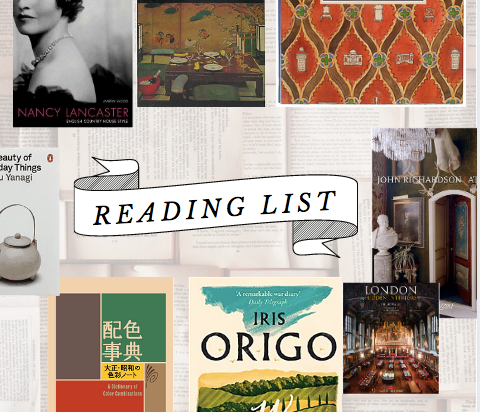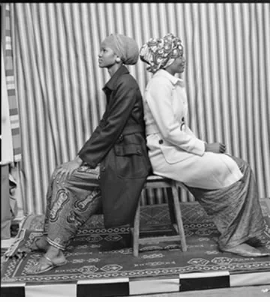- Tat London

- Apr 23, 2021
- 5 min read
Updated: May 6, 2021

If you're anything like me, the phrase 'Reading List' fills you with terror. But over the last few months, I have been sorely missing a bit of inspiration - Instagram is terrific for so many things, but to take an image in sometimes (most of the time), I prefer it via a book or magazine. I recently bought 'Mlinaric on Decorating' It filled me with joy and now sits on my shelf among my favourite interiors and design books (Interiors of Chester Jones, Perfect English Townhouse, The World of Madeleine Castaing & Jaime Parlade). So I thought it might be interesting to ask inspiring people what books inspire them. Here are their answers below. Get your wish list at the ready.
Alex Tieghi-Walker, Founder of TIWA
This book has been so important for me to learn about the processes and intuitions of a lot of makers I work with, who are all creating modest, honest, handcrafted objects. The collection of essays written by Soetsu Yanagi observes the innate beauty held by everyday objects because they were forms that evolved out of pure functionality. These objects are created by the ever evolving needs of generations and the changing nature of tasks, and is so thoughtfully and perfectly written.

Compiled by the Japanese artist, teacher, costume and kimono designer in the 1930s (at a time when Japanese culture was being changed by Western influence), this book of plates and colour charts laid the foundations for contemporary colour research. I love seeing the different plates alongside images of actual objects that were manufactured at the time using the colour combination guidelines; the context is so perfectly presented.
Ambrice Miller, Founder of Relic Interiors
Without a doubt, one of my favourite design books is “John Richardson: At Home.” The book chronicles Richardson’s homes throughout his life while exploring how each residence has left a lasting impression on him or vice versa. The images of his Connecticut Estate inspired by Schinkel Pavilion in Berlin are particularly inspiring. The decor can simply be described as a theatrical and tastefully curated hoard that would satisfy even the greediest of eyes.
I adore this book because it reiterates the most basic of design philosophies: your home should unapologetically be a reflection of you and your taste whatever that should be.
Terry Ellis, Director of fennica
Mainly posed studio portraits in black and white from the 1960s to the 1980s. This was the golden age of African portrait photography.

The catalogue for the 2017 exhibition at the Guggenheim. It examines the influence that Albers’ travels to pre-Colombian Monuments in Mexico had on his geometric paintings.
Miranda Sinclair, Senior Editorial Stylist at The World of Interiors
Creator and maker of cards and bespoke paper goods.

London’s Hidden Interiors by Phillip Davies- like the brilliant Open House weekend it’s a peek into some of the grandest, sometimes weird but always inspiring buildings in London which are normally closed to the public. After this year of being locked away in my very small house, it’s been a wonderful escape this year.

Tiffany Table Settings book. from the '60s. I managed to keep my best friends copy on my own bookshelf for nearly a decade!- she actually had to steal it back after dinner one night as she had given up asking me to return it. We used to love the fabulous table settings and napkin art and try to recreate scenes for friends birthday dinners. Even the dated and slightly dodgy styling I enjoy a lot! Very useful should you find yourself having to set the table for an "Executive Luncheon"!?

Lastly Josef Frank Textile design book by Kristina Wangberg-Erikson. Because I think he is my fav. This book shows you his sketches and pictures of completely brilliant things made from his textiles. Like a long summer evening gown made from the Tulipan patterned chintz. Or an entire room covered in a matching pattern on the walls, ceilings, chairs, lampshades and tablecloths. I slowly leaf through it hoping that if I look hard enough, maybe one day, by some sort of osmosis- I will be able to draw and paint textiles like that. It hasn't happened yet!?
Ros Byam Shaw, Writer on interiors, and author of books, including Perfect English and English Eccentric.
I have long been fascinated by Nancy Lancaster - the American heiress who bought Colefax and Fowler in the 1930s and is often credited with crystallising the style of decoration that has come to be known as ‘English Country House Style’ - and there is an excellent biography of her by Martin Wood that has descriptions and photographs of all the houses she lived in and decorated. Even though her houses were mostly large and grand, she had a brilliant knack of making them welcoming and comfortable. I would love to have been a house guest in one of them to be ushered up to a carpeted bedroom with a fire burning in the grate and a four-poster bed made up with Porthault sheets and a silk eiderdown. Some of the descriptions of her rooms make my mouth water - like the London bedroom that was decorated for her by Mrs Bethell, its walls lined with white silk, its bed hung with old white damask trimmed with antique silver lame. The fitted carpet was also white, and old gilt mirrors hung on the wall. Nancy described the effect as ‘like ice with a glint of gold.’ Her three ‘tricks’ - open fires, candlelight, and masses of flowers - can be applied pretty much anywhere - or at least two of them can.

I refer to 'Mark Hampton on Decorating’ several times a year it’s always relevant, charmingly written and beautifully illustrated.
Sarah Watson, Founder of Balineum
The Tile Gazetteer is a guide to interesting tile and ceramic locations around Britain. You can take with you when travelling and it is arranged by Country > Region > Town – so wherever you are you can look up to see if there might be some interesting building and tiles nearby. It is very text-heavy, so not for the faint of heart or the dyslexic amongst us but I love it. And it's almost just small enough to fit into a handbag, so I try to take it with me whenever I am travelling around the UK for either work or holidays.

A recent addition to my library - which I just picked up after spotting in the window of a charity shop in Oxford, is Stillness & Light, The Silent Eloquence of Shaker Architecture. The photography. The scale. The light. Those Shakers really know how to design a building and beautifully edited by Henry Plummer who is a Professor for Architecture.
War in the Val d’Orcia, which is Iris Origo’s extraordinary account of life on her exquisitely beautiful agrarian estate in Tuscany, during World War II. Origo was a supremely gifted writer and the book is a gripping account of day-to-day life which included anything from taking in refugee children whose parents worked in bombed-out factories in Turin, to sheltering Allied prisoners of war on the run from the Nazi occupation after Italy’s capitulation in 1943. The simple acts of kindness performed by Origo and those around her, on all sides, lend humanity to a tragedy that was so devoid of it.

The Last of the Duchess, by Caroline Blackwood. The Duchess of Windsor spent the last decade of her life in total remote seclusion within the relative luxury of her home in Bois de Boulogne. Infirm and incapacitated she was increasingly isolated from the world by her controversial and fearsome lawyer, Maitre Suzanne Blum. Caroline Blackwood, tasked with writing a profile of Blum in the 80s ultimately published this incredible work after Maitre Blum had died - so concerned was she with the possibility of a liable suit. Only someone with a flair for Gothic drama like Blackwood could write such a dark and caustic, but enormously wry account.















Comments